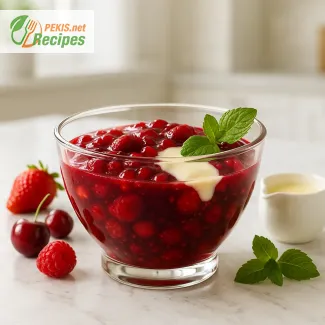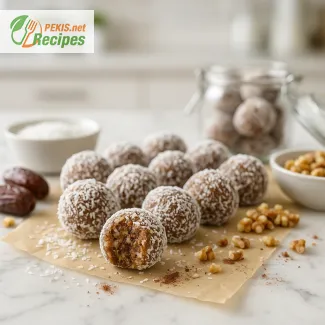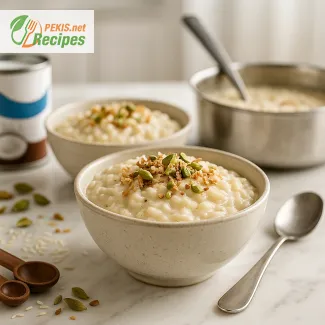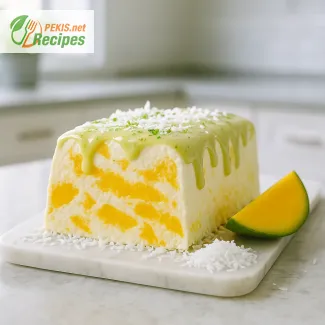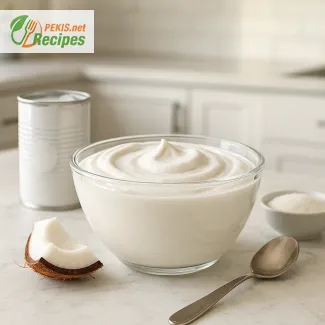Chestnut purée delivers 4 servings in 20 minutes (prep 20, cook 0): a silky, no-cook blend of cooked chestnuts, cream, milk, vanilla, a touch of lemon, and salt for clarity. Expect a café-style spoonfeel that pipes cleanly and spreads smoothly—perfect for verrines, cake layers, or elegant dollops. Keep covered and chilled for up to 48 hours (brief whisk restores sheen); serve straight from the fridge for make-ahead ease.
PEKIS — professional chef and recipe developer with 25+ years in cooking and baking, specializing in European and international cuisine. For chestnut purée, I’ve refined no-cook techniques—single-pass sieving, brief whipping, and controlled hydration—to keep the texture silky without turning pasty. I routinely test pairings like vanilla, espresso, and citrus to balance sweetness and highlight chestnut’s nutty depth, plus make-ahead methods that hold clean piping lines for service.
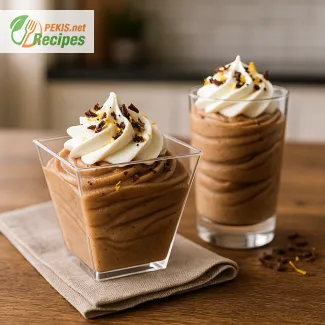
Ultra-smooth chestnut purée with café-style finish – no-cook, 20-minute method
Quick guide to a flawless texture
Feather-light and silky, this chestnut purée leans into the natural sweet, nutty depth of chestnuts while staying no-cook and weeknight-friendly. Gentle aeration and balanced sweetness deliver a dessert-shop spoonfeel that spreads like a cloud, pipes cleanly, and sets softly for parfaits, verrines, or layered cakes.
Texture and technique – whipped purée, sweet chestnuts, Franco-Italian dessert craft
A smooth mouthfeel depends on minimizing graininess, controlling water activity, and adding just enough richness to round the chestnut’s earthy notes. A brief blend, followed by a fine sieve pass, removes fibrous bits for a velvet finish. Light whipping incorporates micro-air for a mousse-like lift without heaviness.
Chestnut purée sits at the crossroads of French marrons traditions and Italian castagne sweets. Today’s version favors clean flavors, restrained sweetness, and no-bake convenience, making it ideal for modern plating, from swirls atop brownies to elegant verrine layers with a glossy topping.
Technique highlights
- Whip briefly, then rest: reduces air bubbles that can pop and roughen the surface.
- Sieve once, blend once: over-processing turns it tacky; one pass is enough.
- Balance richness and fluidity: aim for soft peaks that hold lines from a spoon.
- Chill before serving: 20–30 minutes firms the structure for neat dollops or piping.
Origin and history
Chestnut sweets trace back to mountain regions across France, Italy, and the Balkans, where chestnuts were a cool-season staple. The celebrated crème de marrons emerged in 19th-century French confectionery, inspiring spreads, fillings, and the iconic Mont Blanc. In Italy, chestnut desserts ranged from rustic castagnaccio to refined pastry creams. Modern patisserie popularized whipped purées and light mousses, favoring silk over density and emphasizing finesse in sieving and brief aeration.
Explore more chestnut desserts in English: try our short-and-sweet cake or a softly set panna cotta for seasonal menus —
Chestnut cake with vanilla cream – Authentic autumn flavors and
Chestnut panna cotta with vanilla sauce for autumn days.
Why you’ll love this recipe
- No-cook, ready fast: a 20-minute path to a restaurant-style finish.
- Silky spoonfeel: fine-sieving yields a velvet texture with zero grit.
- Balanced sweetness: chestnut’s caramel-nutty profile shines, not sugar.
- Versatile plating: dollop, pipe, spread, or layer in verrines and cakes.
- Make-ahead friendly: holds its form after chilling, great for guests.
- Refined yet simple: minimal handling, maximum pâtisserie elegance.
- Seasonal flexibility: pairs with vanilla, cocoa, coffee, rum, or citrus.
Key ingredient effects
- Starch/flour: Chestnut’s native starches thicken the matrix; a tiny boost of neutral starch can tighten body for cleaner piping.
- Fats: A measured creamy element softens fibers, adds gloss, and prevents pastiness; too much dulls flavor and weighs it down.
- Acids: A whisper of gentle acidity (think bright notes) lifts sweetness and sharpens chestnut aroma without curdling the base.
- Sugars: Fine sugar or a smooth sweetener dissolves quickly, enhancing silkiness; darker styles add caramel depth but can mask nuance.
- Salt: A pinch heightens nutty tones, reins in sweetness, and improves overall flavor clarity.
- Proteins: Light dairy proteins stabilize micro-air for a soft, mousse-like body; over-whipping leads to grainy separation.
- Liquids: Controlled hydration determines flow: less for pipeable swirls, more for spreadable layers; add slowly to avoid thinning.
- Spices/herbs: Vanilla, cocoa, espresso, cinnamon, tonka, citrus zest accentuate warmth; use sparingly to keep chestnut front and center.
- Leavening/setting agents: Not essential; a brief chill naturally sets the purée. A touch of gelatin or agar can give a firmer spoon cut if needed.
- Heat treatment: No heat preserves delicate aromatics; if using pre-cooked chestnuts, a gentle warm-through before blending can ease sieving.
Creative variations
- Vanilla-bean swirl – fold in fragrant vanilla paste for a pastry-cream vibe without heaviness.
- Mocha chestnut – blend a short espresso for bittersweet depth that balances sweetness.
- Cocoa-kissed – sift in a touch of unsweetened cocoa for a truffle-like nuance and darker hue.
- Citrus lift – micro-zest orange or yuzu for brightness that cuts through richness.
- Rum-parfait style – finish with a drop of dark rum for a classic Mont Blanc echo.
- Coffee-praline crunch – top with a fine nut brittle shards to contrast the silk base.
Storage and make-ahead
- Chill covered: store in an airtight container to prevent surface drying and odor pickup.
- Best within 48 hours: texture stays silky; stir briefly before serving to restore sheen.
- Re-whip lightly: a short whisk revives soft peaks if the purée settles.
- Freezing: possible but may dull aroma and alter texture; thaw slowly in the fridge, then whisk smooth.
- Service timing: pipe or spread just before plating for the cleanest edges.
- Soften and prep: If using whole cooked chestnuts, pulse briefly until crumbly. For canned/packaged purée, loosen with half the milk for easier blending.
- Blend to silk: Add chestnuts, heavy cream, remaining milk, sugar, vanilla, lemon juice, and salt to a blender. Blend briefly until smooth and airy; avoid over-processing, which can make the texture tacky.
- Sieve once: Press the purée through a fine mesh sieve for a perfectly velvety finish.
- Adjust texture: If piping is planned, the mixture should hold soft peaks; add a splash of milk for a spreadable layer or blend 10–15 seconds more for extra lightness.
- Chill: Cover and refrigerate 20–30 minutes to set the structure and polish the surface sheen.
- Serve: Spoon, pipe, or spread into glasses or onto cakes. Finish with whipped cream (decoration) and dark chocolate shavings (decoration) if desired.
Assembly ideas (optional)
- Swirl into verrines, then top with a thin espresso drizzle (sauce) for bittersweet contrast.
- Spread as a cake layer and finish with a cocoa dusting (decoration) for a truffle-like note.
FAQ questionHow do I keep chestnut purée silky and not grainy?
Graininess usually comes from over-processing or skipping a fine-mesh sieve. Blend briefly just to smooth, then pass the mixture through a sieve once to remove fibrous bits. Keep hydration controlled—add liquid slowly so starches don’t seize—and finish with a short chill (20–30 minutes) to set a satin texture.
FAQ questionCan I use canned chestnut purée instead of cooked chestnuts?
Yes. Choose unsweetened canned purée for precise control over sweetness. Loosen it with a little milk or cream before blending, then sieve once. If using sweetened “crème de marrons,” reduce added sugar and consider a pinch of salt or a citrus note to balance.
FAQ questionHow do I make it pipeable for cakes vs. soft for verrines?
For pipeable swirls, aim for soft peaks: use slightly less liquid and a brief whip to incorporate micro-air. For spreadable or spoonable textures, increase liquid in small splashes until ribbons disappear within a few seconds. Always chill before service to stabilize the structure.
FAQ questionWhat flavors pair best without overpowering chestnuts?
Chestnut shines with vanilla, espresso, dark cocoa, rum, and citrus zest. Use accent flavors sparingly so the nutty, caramel-like profile stays central. For toppings, think light whipped cream, chocolate shavings, or a fine cocoa dusting for contrast.
FAQ questionHow long does chestnut purée keep, and can I freeze it?
Refrigerate, covered, for up to 48 hours; whisk briefly to restore sheen before serving. Freezing works but can mute aroma and change texture—thaw overnight in the fridge, then whisk smooth. For best results, serve from fresh or short-chilled batches.
FAQ questionHow can I make a dairy-free or lighter version?
Swap cream with full-fat coconut cream and milk with a neutral plant drink; chill longer for body. For a lighter profile, use a higher ratio of milk to cream and keep aeration gentle. A pinch of salt and a touch of acidity help keep flavors bright.
Silky chestnut purée in 20 minutes brings café-style finesse without heat: a no-cook blend, a brief blend, one fine-mesh sieve pass, and a short chill for a satin finish. Texture control is simple—adjust hydration for soft peaks when piping or a looser ribbon for layering.
Flavor stays centered on chestnut’s nutty, caramel warmth, lifted with vanilla, espresso, dark cocoa, or a touch of citrus. A small pinch of salt sharpens definition, while restrained sweetness keeps the profile clean and modern.
Serve in verrines, as a cake layer, or as neat dollops under crunchy garnish. Hold covered in the fridge for up to 48 hours; a quick whisk restores sheen and flow. For dairy-free service, use full-fat coconut cream and a neutral plant milk, then extend the chill for body.
From weeknight desserts to plated dinners, this purée delivers pipeable stability, spreadable smoothness, and reliable make-ahead performance. Minimal steps, maximum payoff—precise technique for an elegant, no-bake result every time.
- Contains: Milk (dairy). Naturally gluten-free if ingredients are certified and free from cross-contamination.
- Dairy-free option: Replace heavy cream with full-fat coconut cream and milk with oat or almond drink; chill longer to set.
- Low-lactose option: Use lactose-free cream and milk; texture and flavor remain comparable.
- Alcohol note (if using rum in variations): omit for alcohol-free service.
- Potassium: ~480 mg – supports fluid balance and muscle function.
- Manganese: ~1.0 mg – cofactor for antioxidant enzymes and metabolism.
- Copper: ~0.5 mg – aids iron transport and connective tissue integrity.
- Vitamin C: ~10 mg – contributes to collagen synthesis and immune defense.
- Folate (B9): ~35 µg – important for cell division and tissue growth.
- Magnesium: ~40 mg – supports nerve signaling and energy release.
- Total polyphenols: ~80 mg GAE – help neutralize free radicals, supporting cellular protection.
- Vitamin E equivalents: ~0.3 mg – contributes to lipid membrane stability.
- Carotenoid traces: <0.1 mg – minor support for oxidative balance.
